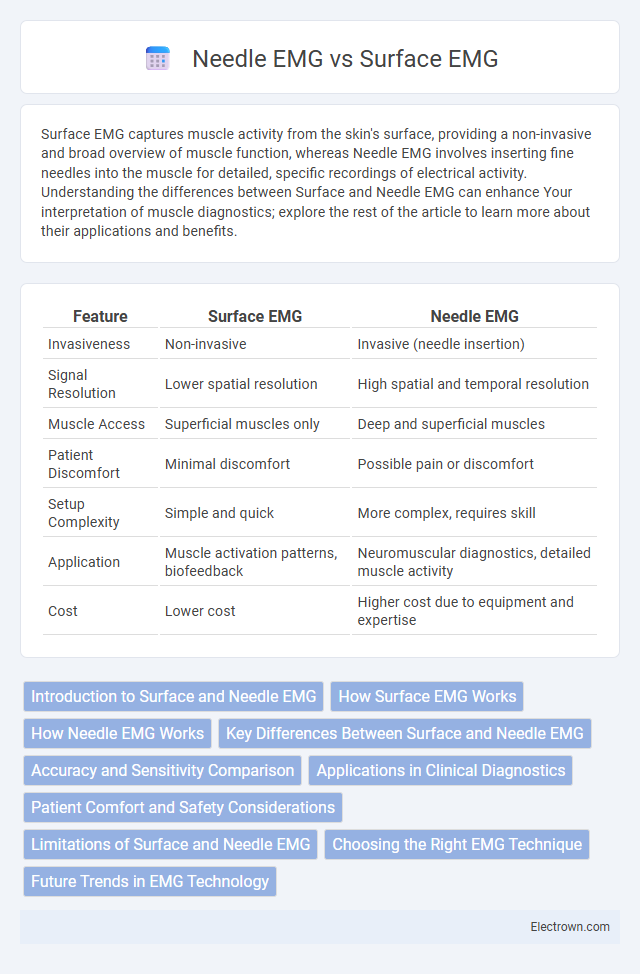Surface EMG captures muscle activity from the skin's surface, providing a non-invasive and broad overview of muscle function, whereas Needle EMG involves inserting fine needles into the muscle for detailed, specific recordings of electrical activity. Understanding the differences between Surface and Needle EMG can enhance Your interpretation of muscle diagnostics; explore the rest of the article to learn more about their applications and benefits.
Table of Comparison
| Feature | Surface EMG | Needle EMG |
|---|---|---|
| Invasiveness | Non-invasive | Invasive (needle insertion) |
| Signal Resolution | Lower spatial resolution | High spatial and temporal resolution |
| Muscle Access | Superficial muscles only | Deep and superficial muscles |
| Patient Discomfort | Minimal discomfort | Possible pain or discomfort |
| Setup Complexity | Simple and quick | More complex, requires skill |
| Application | Muscle activation patterns, biofeedback | Neuromuscular diagnostics, detailed muscle activity |
| Cost | Lower cost | Higher cost due to equipment and expertise |
Introduction to Surface and Needle EMG
Surface EMG captures muscle electrical activity using electrodes placed on the skin, offering a non-invasive method ideal for monitoring muscle function during dynamic movements. Needle EMG involves inserting fine electrodes directly into muscle tissue, providing highly precise data on individual motor unit activity and diagnosing neuromuscular disorders. Understanding these differences helps you select the appropriate technique based on the required sensitivity and clinical or research application.
How Surface EMG Works
Surface EMG works by placing electrodes on the skin over the muscle, detecting the electrical signals generated during muscle contractions without penetrating the skin. These electrodes capture the summation of motor unit action potentials, allowing non-invasive monitoring of muscle activity and intensity. This method offers a comfortable and practical approach for assessing muscle function in various clinical and research settings.
How Needle EMG Works
Needle EMG works by inserting a fine needle electrode directly into the muscle to record electrical activity from individual muscle fibers, providing precise and localized data about muscle function. This technique allows for the detection of abnormal electrical patterns that surface EMG might miss due to its broader, less specific signal capture. If you need detailed muscle diagnostics, needle EMG offers superior accuracy by isolating single motor unit action potentials.
Key Differences Between Surface and Needle EMG
Surface EMG uses non-invasive electrodes placed on the skin to record muscle activity, offering ease of use and comfort but limited specificity for deep muscles. Needle EMG involves inserting fine needles directly into muscle tissue, providing detailed information about individual motor units and detecting abnormalities with higher precision. Understanding these key differences helps you choose the appropriate EMG type based on diagnostic needs and patient comfort.
Accuracy and Sensitivity Comparison
Surface EMG provides non-invasive monitoring of muscle activity with moderate accuracy but lower sensitivity to deep muscle signals. Needle EMG offers higher accuracy and sensitivity by directly recording electrical activity from individual muscle fibers, enabling precise detection of subtle neuromuscular abnormalities. Your diagnostic choice depends on the need for detailed muscle assessment versus non-invasive evaluation.
Applications in Clinical Diagnostics
Surface EMG is widely used for non-invasive monitoring of muscle activity in rehabilitation and neuromuscular disorder assessments, providing valuable data on muscle coordination and fatigue. Needle EMG offers precise diagnostics by evaluating muscle electrical activity at a deeper level, essential for detecting denervation or myopathy in clinical settings. Your choice between these techniques depends on the required diagnostic detail, with surface EMG ideal for general muscle performance analysis and needle EMG critical for in-depth neuromuscular pathology evaluation.
Patient Comfort and Safety Considerations
Surface EMG offers increased patient comfort by using non-invasive electrodes placed on the skin, reducing discomfort and the risk of infection. Needle EMG involves inserting fine needles into muscles, which may cause mild pain, bruising, or bleeding, making safety precautions essential. Your choice between these methods should weigh the balance between patient comfort and the diagnostic detail required.
Limitations of Surface and Needle EMG
Surface EMG is limited by its inability to accurately detect deep muscle activity due to signal interference from surrounding tissues and lower spatial resolution. Needle EMG, though more precise in recording individual motor unit action potentials, is invasive, causing discomfort and risk of infection. Both techniques face challenges in distinguishing overlapping signals from adjacent muscles, impacting diagnostic clarity.
Choosing the Right EMG Technique
Choosing the right EMG technique depends on the clinical or research goals, with surface EMG providing non-invasive recording of muscle activity ideal for superficial muscles and general muscle function assessment. Needle EMG offers precise, localized recordings from deep or individual muscle fibers, making it essential for diagnosing neuromuscular disorders and evaluating motor unit potentials. Factors such as patient comfort, muscle depth, and the need for detailed signal analysis guide the selection between surface and needle EMG.
Future Trends in EMG Technology
Future trends in EMG technology emphasize enhanced accuracy and wearable integration, with surface EMG advancing through improved sensor materials and machine learning algorithms for real-time muscle activity analysis. Needle EMG continues to evolve with refined microelectrode designs, enabling more precise motor unit action potential detection and minimally invasive diagnostics. Emerging hybrid systems aim to combine surface and needle EMG strengths, fostering comprehensive neuromuscular assessment in clinical and rehabilitation settings.
Surface vs Needle EMG Infographic

 electrown.com
electrown.com